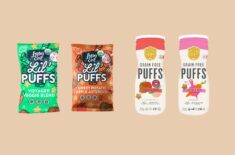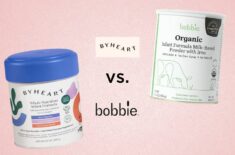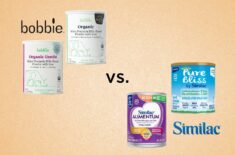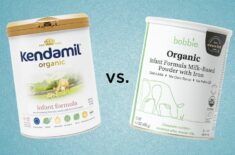Overview
Myth: Feeding oatmeal in a baby’s bottle will make babies sleep through the night.
Fact: A study published in the National Library of Medicine showed no difference in regards to sleeping through the night between babies fed cereal in a bottle and those who were not. (1)
Oatmeal cereal is a common go-to when choosing your baby’s first food. Understandably because oatmeal is easy to prepare, and most oatmeal cereals are fortified with iron, essential for your baby’s growth and development. (2)
But you may already know that there’s more to oatmeal than just a quick and easy breakfast for babies and the whole family.
In this article, we’ll discuss oatmeal’s nutritional value and health benefits, food safety risks, and allergic reactions. We also prepared yummy oatmeal recipes that your baby and the entire family can enjoy. Dig in!
What’s BLW?
BLW pioneer Dr. Gill Rapley defines BLW (baby-led weaning) as a self-feeding approach where your baby takes the lead and decides when, what, and how much they want to eat from the healthy food choices you prepared. (3)
When Can Babies Eat Oatmeal?
At six months old, most babies can start eating solid foods. (4)
To know if you can feed your baby oatmeal and other solid foods, check out these signs of readiness for solids.
Top Reasons To Serve Oatmeal In BLW
- Easy to prepare
- No added sugar
- Perfect for babies and toddlers
- Can be prepared in advance
- Customizable, which allows baby to explore different food textures
- Can be shared with the whole family
Nutrition Facts
A tablespoon or 3.8 grams of oatmeal cereal contains: (5)
Energy: 15 kcal
Fat: 0.2 g (0% of the Daily Value)
Carbohydrates: 2.8 g (1% of the DV)
Fiber: 0.3 g (1% of the DV)
Protein: 0.4 g (1% of the DV)
Iron: 2.4 mg (13% of the DV)
Calcium: 44 mg (3% of the DV)
Potassium: 21 mg (0% of the DV)
Vitamin B12: 0.17 mcg (7% of the DV)
Folate: 15.05 mcg (4% of the DV)
Phosphorus: 19.23 mg (3% of the DV)
Magnesium: 4.18 mg (1% of the DV)
Zinc: 0.48 mg (4% of the DV)
Health Benefits
Promotes A Healthy Heart
Oats are well-known for their heart health benefits, including reduced risk of cardiovascular diseases, lower blood cholesterol, and lower blood pressure. (6)
Research has found that daily intake of 3 grams of beta-glucan soluble fiber decreased blood cholesterol levels by 12 points. (7)
Can Balance Blood Glucose
Oats may also help prevent a sudden increase in blood sugar and insulin levels after meals.(8)
Supports Healthy Digestion
Fiber regulates bowel movement and prevents constipation. In fact, cereal fibers found in oat bran are more effective in regulating bowel movement than fiber found in fruits and veggies. (6)
Anti-Cancer Effects
Oats might help prevent gastrointestinal problems and may have anti-cancer effects. (9)
Promotes Healthy Cells
Although oats are not a good source of vitamin C and vitamin A, they’re a good source of B-vitamins, consisting of 5% of the daily value per tablespoon of oatmeal cereal. (5)
Vitamins B1, B2, & B3 are essential for the growth, development, and proper functions of the cells in your growing baby’s body. Additionally, vitamin B3 or niacin converts food to energy. (10)(11)(12)
Oatmeal Brands We Recommend
One Degree Organic Foods, Sprouted Rolled Oats
Purely Elizabeth Superfood Oatmeal (Classic Cinnamon)




Purely Elizabeth (Multi-Pack) Prebiotic Banana Nut Oatmeal
Nature’s Path Organic Homestyle Instant Oatmeal (Gluten-Free)
Bob’s Red Mill Organic Old Fashioned Rolled Oats (Gluten-Free)
MUSH Blueberry Overnight Oatmeal


MUSH Apple & Cinnamon Overnight Oat
Thrive Market, Organic Quick Oats (Original)
Food Safety With Oatmeal
Is Oatmeal A Choking Hazard?
Oatmeal is not a common choking hazard. Even so, it’s best to maintain a safe environment for your little one during mealtimes and to educate yourself about common choking hazards and prevention tips.
Is Oatmeal A Common Allergen?
Yes. Oats is one of the 14 most common food allergens alongside crustaceans (prawns, crabs, lobsters), eggs, fish, peanuts, soybeans, cow’s milk, nuts, celery, mustard, sesame seeds, preservatives sulfur dioxide and sulfites, lupin (legume), and mollusks (squid, mussels, oysters, snails). (13)
A protein in oats called avenin is similar to gluten and can cause the same allergic reactions such as: (14)
- Hives or rash
- Mouth and throat irritation
- Eye irritation
- Stuffy nose
- Nausea and vomiting
- Diarrhea
- Trouble breathing
- Anaphylaxis
In addition, while pure oats are gluten-free, most commercial oats are processed in facilities that produce gluten-containing products, leading to cross-contamination. Another factor that leads to oat-gluten cross-contamination is when oats are grown close to wheat crops.
If such cross-contamination occurs, it isn’t easy to know the exact amount. That’s why the FDA (U.S. Food and Drug Administration) regulated the term “gluten-free” for products with less than 0.002% of gluten. (6)
Important: If you have celiac disease or sensitivity to gluten, choose oats that are specifically labeled gluten-free. (6)
Foods & Products To Avoid If You Have Oat Allergy
- Granola Bars
- Cereal
- Oat Flour
- Cookies
- Pudding
- Beer
- Oat Moisturizers
- Oat-Based Milk & Creams
- Oat-Based Facial Scrubs (15)
Oats FAQs
Can You Give Babies Regular Oatmeal?
Regular oatmeal has a coarse texture that may be too tough for your baby to gnaw and digest.
Can You Start Babies On Oatmeal Instead Of Rice Cereal?
Yes, you can. This depends on your preferences and your baby’s reaction to new food since both oatmeal cereal and rice cereal have health benefits for your growing baby. To learn more, read our full article about rice cereal and oatmeal cereal here.
When Can You Put Oatmeal In A Baby’s Bottle?
Feeding your baby oatmeal or cereal in a bottle is not advisable because this can cause gagging and/or inhaling the thick mixture into their lungs. Unless your baby’s pediatrician advised doing so, it’s best to serve solid foods like oatmeal in a bowl or spoon when they are developmentally ready for solids. (16)
Which Oatmeal Is Best For Baby?
Quick Oats (Iron-Fortified, Gluten-Free)
This is the easier choice for baby food since it’s the fastest to cook and prepare and has a finer texture than other oat types. Choosing iron-fortified baby cereals can be good since they have more iron, essential for your little one’s growth and development. (2)
Rolled Oats (Old-Fashioned Oats)
Rolled oats are more versatile to prepare and require less cook time than steel-cut oats. It’s easy to prepare yummy breakfast recipes like a puree with coconut milk or finger food recipes like porridge fingers using rolled oats.
Steel-Cut Oats
Steel-cut oats are good for your baby’s first foods when blended into a smooth puree. Otherwise, it’s perfect for oatmeal recipes for 10+ months old babies since it’s chewier.
How To Make Homemade Oatmeal Cereal
- Grind 1/2 cup regular oats in a food processor for 15-30 seconds.
- To make one serving for a 6-9 month old baby, bring ½ cup of water, breast milk, or formula to a boil and add two tablespoons of ground oats.
- Stir continuously for the first 30 seconds, then stir occasionally for the next 3-5 minutes or until the mixture is to your desired consistency.
- You can store the rest of the oat powder in an airtight container in the fridge or a cool dark place.
Note:
Most storebought oatmeal cereals are fortified with iron, a nutrient that babies need for their optimum growth and development. A homemade oatmeal cereal will not have this.
What you can do is mix homemade oatmeal cereal with natural iron sources like spinach puree, quinoa, lentils or consult your baby’s pediatrician about infant iron supplements.
It’s also good to make sure you’re feeding your baby high-iron foods like meat, chicken, and meatballs.
How Do You Feed Oatmeal For Baby Led Weaning?
Can I Give My 4 Month Old Baby Oatmeal Cereal?
The general recommended age for introducing solid foods to babies is six months of age or when they are developmentally ready for solids. If you think your four-month-old might be ready for solids, here’s an informative article for you. (4)
Can I Give My 6 Month Old Baby Oatmeal?
Yes. You can prepare easy recipes with oats like a puree or oatmeal cereal when your baby is around six months old—more on this below.
How To Give 8-10 Month Old Babies Oatmeal
You can serve oatmeal cereal, puree, and other oats recipes like baked oatmeal with fruits like blueberries.
How To Give 12+ Month Old Babies Oatmeal
At this age, you can serve finger foods like oatmeal fingers, top with shredded coconut, or mix with peanut butter.
Important:
Peanut allergy is a common food allergy in children in the U.S. Make sure to consult your baby’s pediatrician before offering peanut butter, especially if there’s a family history of peanut or any other food allergy. (17)
Serve multi-ingredient food to your child only if you have introduced each food separately before serving them together.
4 Ways To Prepare Oatmeal For Babies, Toddlers, & Adults
1. Oatmeal Puree
Serve oatmeal puree in multiple ways, like adding applesauce or steamed apples. You can also mix with fruits and veggie purees like pear and carrots for added flavor.
2. BLW Finger Foods
Let the oatmeal cool and stick together to form clumps that are easier for your little one to pick up. You can also bake oatmeal then cut it into easy-to-grab strips as thick as two adult fingers pressed together.
Blueberry Oatmeal Bars
Preheat oven to 350ºF. In a blender or food processor, put a cup of oats, then blend until fine. Add a cup of blueberries, blend, then transfer to a bowl with a cup of nut butter, ½ cup coconut oil, a teaspoon of vanilla extract or cinnamon, then mix well until fully combined. Line a parchment paper on a baking tray, pour the mixture, then press down using a spoon. Bake for 15 minutes if you want it gooier or 20 minutes if you like it cooked thoroughly, cool, slice into bars, then serve.
Strawberries & Cream Overnight Oats Jars
Blend ½ cup diced strawberries, ½ cup breast milk or almond milk, and ½ teaspoon vanilla extract until smooth. Put ½ cup rolled oats, half a tablespoon of chia seeds, and a tablespoon of hemp seeds in a jar, pour the strawberry/milk mixture, then stir until fully combined. Add ⅓ cup coconut yogurt, then stir. Cover the jar, then refrigerate overnight or at least four hours. You can add more milk to thin the mixture and your toppings of choice.
3. Oatmeal For Toddlers
Serve oatmeal topped with fresh or frozen fruits like blueberries, strawberries, or mangoes with some chicken-blueberry breakfast meatballs as a well-balanced brekkie.
4. Oatmeal For Adults
Load a bowl of whole oats cereal and top it with sliced bananas with chia seeds or mix with whole milk or coconut yogurt. Oatmeal and ricotta cheese is also a good combination.
Oatmeal For Baby Variations
- Dairy-free: Use breast milk, almond milk, or other plant-based milk alternatives.
- Gluten-free: Choose gluten-free quick oats.
- Egg Free: Replace the egg using a tablespoon of flaxseed mixed with three tablespoons of preferred milk, then whisk until gelatinous.
- Add fruits: Mashed banana, kiwi, raspberries, or sweet potato.
- Add in quinoa, chia seeds, or hemp seeds.
- Top with shredded coconut, coconut yogurt, or runny peanut or nut butter. (Only if you’ve already introduced these ingredients because they are common food allergens.)
Helpful BLW Tools For Mealtimes
REFERENCES
:
(1) https://pubmed.ncbi.nlm.nih.gov/2672785/
(2) https://ods.od.nih.gov/factsheets/Iron-Consumer/
(3) http://rapleyweaning.com/assets/Defining_BLW_v2.pdf
(4) https://www.cdc.gov/nutrition/InfantandToddlerNutrition/foods-and-drinks/when-to-introduce-solid-foods.html
(5) https://www.nutritionvalue.org/Oatmeal_cereal%2C_instant%2C_dry%2C_baby_food_57804000_nutritional_value.html
(6) https://www.hsph.harvard.edu/nutritionsource/food-features/oats/
(7) https://pubmed.ncbi.nlm.nih.gov/21470820/
(8) https://pubmed.ncbi.nlm.nih.gov/26690472/
(9) https://www.ncbi.nlm.nih.gov/pmc/articles/PMC4325078/
(10) https://ods.od.nih.gov/factsheets/Thiamin-Consumer/
(11) https://ods.od.nih.gov/factsheets/Riboflavin-Consumer/
(12) https://ods.od.nih.gov/factsheets/Niacin-Consumer/
(13) https://www.fsai.ie/legislation/food_legislation/food_information_fic/allergens.html
(14) https://www.nyallergy.com/oat-allergy/
(15) https://www.nyallergy.com/oat-allergy/
(16) https://www.healthychildren.org/English/ages-stages/baby/feeding-nutrition/Pages/Cereal-in-a-Bottle-Solid-Food-Shortcuts-to-Avoid.aspx
(17) https://acaai.org/allergies/allergic-conditions/food/peanut/

















